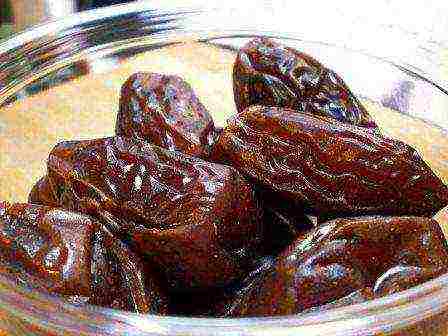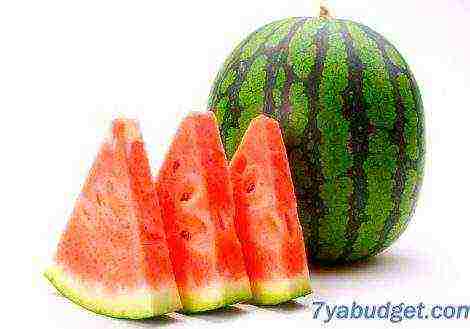Content
3 parts: Basic growing method Growing mushrooms on coffee grounds Alternative growing methods
Growing mushrooms at home is a task that anyone interested in growing food for their own consumption should tackle at least once. Mushrooms are a useful addition to any diet because they are low in calories and fat, but high in fiber and potassium. Plus, they're easy to grow at home. Mushrooms are best grown in an area where temperature and conditions are easy to manage. Knowing how to grow mushrooms at home will help you carefully manage your growing conditions.
Part 1 The main method of growing
-
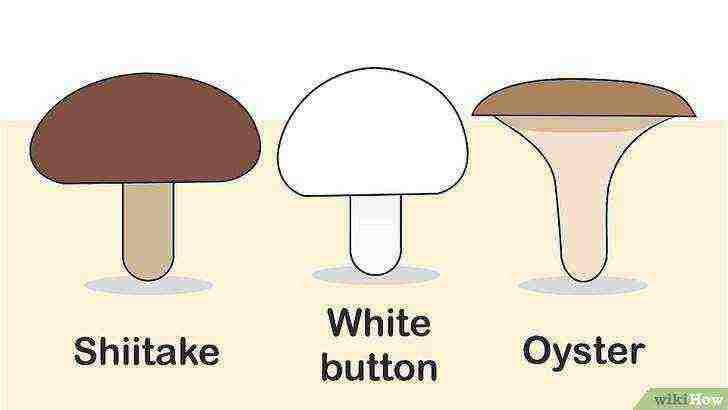 Choose the type of mushroom to grow.
Choose the type of mushroom to grow.
There are 3 types of mushrooms that are easiest to grow at home: oyster mushrooms, champignons and shitaki. The cultivation method for each type of mushroom is similar, but the ideal growing medium is different.
- Oyster mushrooms are best grown in straw. Shiitaks grow better on deciduous sawdust, and mushrooms grow on compost manure. These different nutrient media reflect the different nutritional needs of each species. However, each of the 3 species is easy enough to grow in sawdust or straw.
- The choice of mushrooms for growing is a matter of taste. You need to grow the mushroom that you want to eat.
-
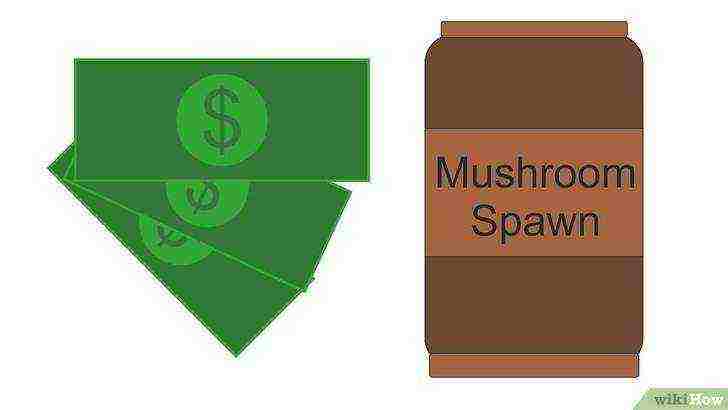 Buy mycelium.
Buy mycelium.
Myceliums are sawdust permeated with fungal mycelium - in fact, the root structure of the fungus. They are used as seedlings of plants to promote growth.
- You can buy high quality mycelium from your online store, gardening store, or other specialty organic store.
- Buy the mycelium, not the spores. Some stores also sell spores that look more like plant seeds (rather than seedlings). Growing mushrooms from spores takes more time and practice and is best suited to a seasoned mushroom grower.
- Sterilize the culture medium.
If you grow mushrooms in straw or sawdust, you must sterilize this substrate before sowing the mycelium. This is done in order to kill any microorganisms that might compete with the mycelium.
- To sterilize the medium, place it in a heat-resistant bowl and add enough water to make the straw or sawdust damp. Place the bowl in the microwave and heat it on high power for two minutes or until the water has boiled away.
- This kills all microorganisms, making it safe for the mycelium to take in. You may have to work in batches to sterilize all straw or sawdust completely.
- Heat the substrate to spread the mycelium in it.
The mycelium must be thoroughly spread in a nutrient medium for the mushrooms to grow. Warm temperatures stimulate growth.
- After choosing a substrate for your mushroom species, place a few handfuls of it in a baking sheet. A shallow baking sheet with a large surface area is ideal for growing mushrooms.
- Stir the mycelium into the substrate with a sterilized spoon or similar. Place the baking sheet on an electric pillow set at 21 ° C. This is the ideal temperature to stimulate growth.
- Leave the unit in a dark environment such as a closet for three weeks. This will allow the mycelium to spread in the nutrient medium.
- Place the substrate in a suitable location.
After three weeks, place the substrate in a dark and cool place (about 13 ° C). As a rule, a basement is suitable for this, but in winter, a closet or drawer in an unheated room will do.
- If you notice green or brown spots on the substrate (like moldy bread), remove the spots and discard.
- Pour a handful of soil onto the substrate and sprinkle everything with enough water to thoroughly wet. You can cover the baking sheet with a damp towel to prevent moisture loss.
- You can place a low heat lamp next to the baking sheet. It will replace the sun, and the mushrooms will begin to reach for it and grow upward, which will further facilitate their collection.
- Keep the mixture moist and cool while the mushrooms are growing. Check it periodically and spray with water as needed.
- Mushrooms prefer coolness. The most important thing is not to let them overheat. At temperatures below 21 ° C, the mushrooms should grow excellently.
- Harvest when the mushrooms are fully grown.
After about three weeks, you will have small mushrooms. Maintain moisture, coolness, and darkening to encourage their growth.
- When the mushroom caps are completely detached from their legs, they can be collected. You can pick mushrooms with your fingers, but you risk damaging newly developing mushrooms below the surface. Better to use a sharp knife to cut the mushrooms at the base of the stem.
- Rinse the mushrooms before cooking. The harvested mushrooms can be stored in a paper bag in the refrigerator for up to seven days.
Part 2 Growing mushrooms on coffee grounds
-
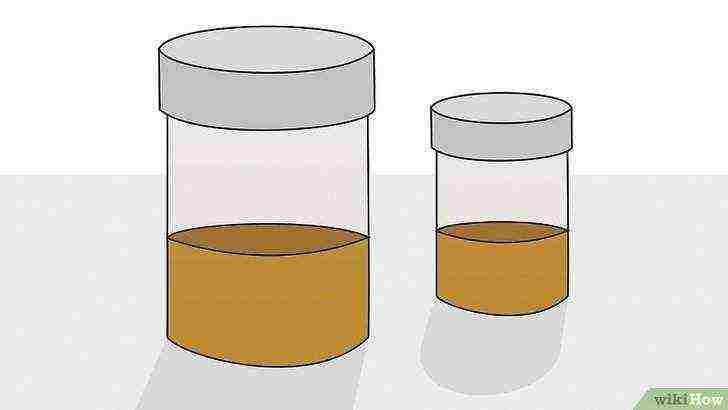 Take out the coffee grounds.
Take out the coffee grounds.
Growing mushrooms from coffee grounds is an interesting project that reuses coffee grounds that would otherwise go to waste. Coffee grounds are an excellent breeding ground for mushrooms (in particular oyster mushrooms), as they are already sterilized during the coffee brewing process and are full of nutrients.
- For 500 g of mycelium, you will need 2.5 kg of fresh coffee grounds. The best way to get that much fresh coffee grounds (brewed on the same day) is in a café and kindly ask. Most likely, they will gladly give it to you.
-
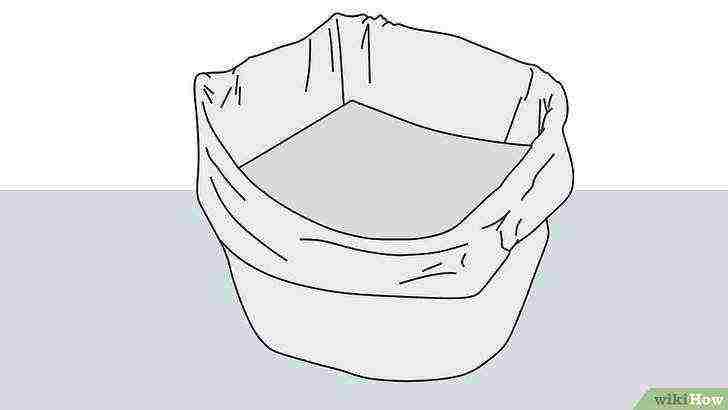
Find a container for mushrooms. It is best to use a special filter bag that can be purchased with the myceliums. If not, you can use a large airtight freezer bag, a cleaned milk carton, or an ice cream carton with four holes punctured in the sides.
-
Transfer the mycelium to a container. Wash your hands thoroughly with antibacterial soap, then stir the mycelium into the coffee grounds, crushing it with your hands to distribute it evenly. Place the seeded coffee grounds in a plastic bag or container and seal tightly.
- Place the mycelium in a suitable environment.
Place the bag or container in a warm, dark place between 18 and 25 ° C, such as under a sink. Leave it on for about three to four weeks until the contents are completely white due to the mycelium settling in the coffee grounds.
- If green or brown spots appear on the substrate, cut them out to avoid poisoning later.
-
Move the mushrooms. When the contents of the bag or container are completely white, move it to a bright place (but not in direct sunlight) and cut a 5x5 cm hole on top.Moist the contents of the container by watering it twice a day to prevent drying out - the mushrooms will not grow too dry conditions.
- Harvest the mushrooms.
Over the next five to seven days, the tiny mushrooms will start to sprout. Keep hydrating them with water and they will double in size daily. When the mushroom caps begin to curl slightly upward, they can be collected.
- When the mushrooms stop sprouting, plant coffee grounds in your garden, cover with bark mulch or compost, and new mushrooms may sprout depending on the weather.
Part 3 Alternative cultivation methods
-
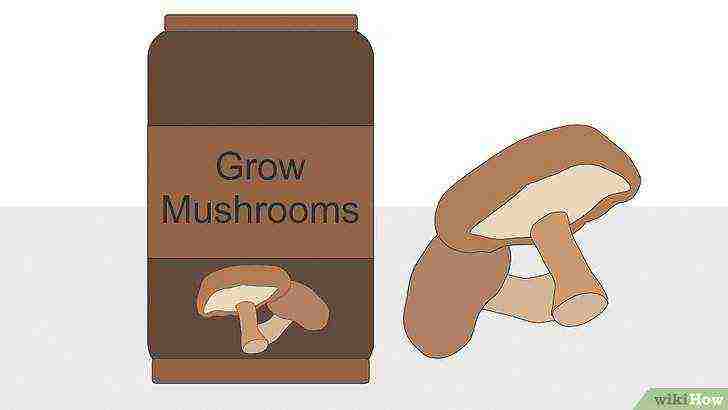 Grow mushrooms from the kit.
Grow mushrooms from the kit.
Growing mushrooms from a ready-made kit is a fun and easy way for beginners. Such kits usually consist of plastic bags filled with sterilized and seeded straw or soil. All you need to do is store the bag in the right conditions for seven to ten days until you have your homegrown mushrooms.
- The sets usually contain the most common varieties of mushrooms such as champignons, shiitake and oyster mushrooms.
- To start growing, simply open the bag and place it in a well-lit area out of direct sunlight, such as a shaded window sill. The kit can be kept at room temperature, but it needs to be moistened daily with water to keep the humidity high. Some kits have plastic tarps to cover the bag and keep the humidity level.
- Mushrooms will begin to sprout after seven to ten days, but within three months they may suddenly start growing two or three more times.
- After you have collected all the mushrooms, you can bury the substrate with mycelium in the garden, sprinkle with bark mulch, or in a compost heap. Then, depending on the weather conditions, the mushrooms will start growing in this place.
- Grow mushrooms on a log.
Another interesting way to grow certain types of mushrooms - such as reishi, ram mushroom, shiitake, oyster mushrooms - on a log. Birch plugs, completely sown with mycelium, are stuck into a piece of log. Stoppers can be obtained online and from specialized mushroom spore suppliers.
- The first thing to do is find a suitable log for growing mushrooms. You will need non-scented deciduous logs such as maple, poplar, oak, or elm. They should be 90-120 cm long and no more than 35 cm in diameter. Cut them out at least two weeks before clogging in order to destroy the natural antifungal properties of the tree.
- To "populate" a piece of log 90-120 centimeters long, you will need about 50 plugs. Use a 5/16 ″ drill to insert the plugs. Make holes 5 cm deep throughout the log in a staggered manner. The distance between them should be about 10 cm. Insert birch plugs into the holes and hammer them in to seal them completely.
- If you plan to leave the log outdoors, you will need to seal the holes with cheese wax or beeswax to protect the plugs from insects and harsh weather. If you will be storing the log at home, in a garage or basement, this is not necessary.
- Over time, the mushroom mycelium will spread on the birch corks throughout the log until the entire piece of wood is inhabited. After complete settlement, the mushrooms will begin to sprout from the cracks in the log. This usually takes 9-12 months, but depending on the temperature and humidity, the mushrooms should reappear from year to year.
Tips
- For more information on growing mushrooms at home and outdoors, read this article.
What do you need
- Mycelium
- Straw, sawdust or manure
- Baking tray
- Heating pad
- Potting soil
- Sprinkler
- Water
- Towel
Article Information
This page has been viewed 84,808 times.
Was this helpful?
There are more than enough mushroom lovers in our country! Only for a hike into the forest for a "quiet hunt" you need the accompanying weather and certain climatic conditions. Not everyone will think about growing mushrooms at home, and even almost on an industrial scale. Most consider this to be fantastic. However, everything is real. And we will tell you how to grow mushrooms in a greenhouse or at home.
What mushrooms can be grown at home
The very idea of growing mushrooms at home poses a choice of a specific species. All varieties suitable for home breeding do not need special material costs or additional efforts. The only exceptions are champignons, but an experienced gardener will cope with this problem too. The choice must be made, first of all, based on the desired profit. All varieties of mushrooms suitable for growing at home can be classified into two main types:
- woody;
- soil.
The former include the well-known shiitake mushrooms, oyster mushrooms, and winter mushrooms. But to the second - no less popular mushrooms and ringlets. Even with small areas, the harvest can be excellent. That is why these varieties are recommended for growing on an industrial scale.
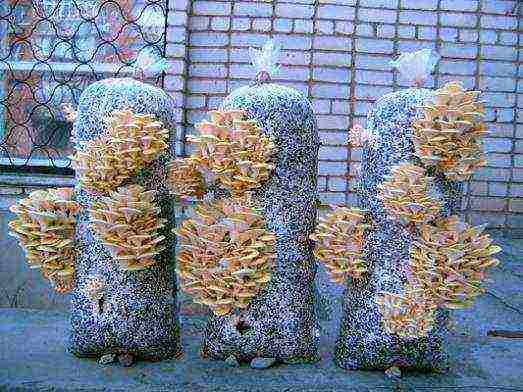 Growing oyster mushrooms at home on the balcony
Growing oyster mushrooms at home on the balcony
Growing technology for beginners
The bulk of the time it takes to grow mushrooms is spent creating mycelium. However, the advice of experienced mushroom growers suggests that it is better to grow this material on your own. After all, even the best and trusted suppliers fail from time to time. Mycelium can be grown in two ways:
- in the grain substrate;
- on wooden sticks.
The choice depends on what kind of mushrooms you plan to grow.
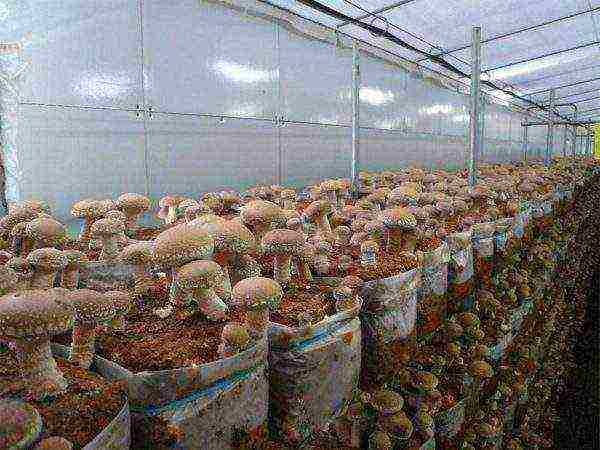 Growing mushrooms on a nutritious substrate
Growing mushrooms on a nutritious substrate
Breeding mycelium
The mycelium is grown in a specific substrate. It is recommended to make sure that its chemical and mineral composition is as similar as possible to that in which mushrooms grow naturally. The composition of this medium must be selected again, depending on the type of mushrooms being grown.
For example, shiitake mushrooms feel more comfortable in wood, mushrooms - in compost, but oyster mushrooms prefer straw. With proper care, chopped straw and sawdust can yield any of these types of mushrooms. However, the substrate must be of high quality. This is ensured by its dryness, absence of mold, as well as unpleasant odors and foreign impurities.
Wheat straw is best suited for growing mushrooms. You can also use rye or barley. Oyster mushrooms are allowed to be propagated in sunflower husks. However, only fresh material should be used, since pathogenic bacteria can grow excellently in old ones.
The mycelium is the backbone of a large number of germinated fungal spores. As soon as this base is placed in the substrate, the process of active growth begins. Initially, only the appearance of thin filaments can be observed, which eventually turn into edible mushrooms.
 Mushroom mycelium
Mushroom mycelium
It is worth purchasing high-quality planting material only in specialized stores. Priority should be given to wood containing viable fungal spores. They will be more resistant to disease. Not planted from grain mycelium. You can also buy common mushroom spores. Only in this case it will take more time and effort to grow your crop. The procedure will resemble the cultivation of any crop from seed. It is better for beginners to avoid this method.
To obtain the maximum yield, it is necessary that the mycelium spreads as thoroughly as possible in the compost. To do this, you need to keep the planting warm. They can be heated using a special electric pillow. Heat is needed only during the incubation period. Once the mushrooms are in the growing phase, it is best to keep them cool. A glazed and insulated balcony is well suited for this.
When growing mushrooms in residential premises, the maturation phase must be avoided. Otherwise, the spores released into the air can provoke allergic reactions and even asthma.
As a rule, seedlings appear in the third week after planting the mycelium.Readiness for harvesting is determined by the hat. You need to cut off ready-made mushrooms only with a knife, so as not to injure those that are still in the soil and are just preparing to give a crop. The ready-made collection can be used both immediately and after preliminary freezing.
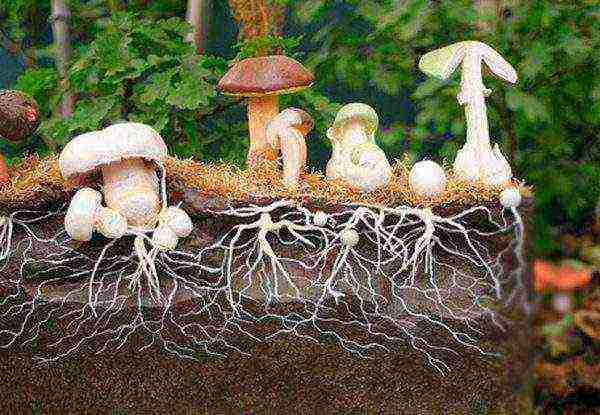 Sectional diagram of mushroom growth from mycelium
Sectional diagram of mushroom growth from mycelium
Other ways to grow mushrooms at home
In addition to the main ones, there are also additional ways of growing mushrooms. True, they do not bring such a large-scale result and are used mainly by children as experiments. For example, some types of mushrooms can be grown on logs. For this logs up to half a meter long are cut from hardwood. This must be done at least 2 weeks before settling with mycelium.
In the resulting blank, holes are made in a checkerboard pattern at a distance of 10 cm. After that, the sticks with mycelium must be sealed. A hammer can be used for this procedure.
Before starting work, you must disinfect your hands and make sure that there is no debris in the holes.
The logs filled with mycelium are placed in the basement and wait until it fills the entire space. The procedure is lengthy and can take up to 1 year. Temperature and humidity are considered key conditions.
A known method of growing mushrooms on coffee grounds. It contains many trace elements:
- manganese;
- potassium;
- magnesium;
- nitrogen.
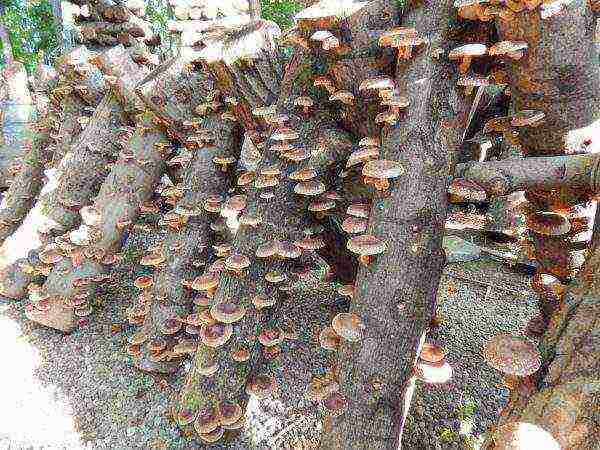 Growing mushrooms on stumps
Growing mushrooms on stumps
This environment is ideal for oyster mushrooms. In addition, the coffee grounds do not need to be sterilized again. The disadvantage of this method is that it is very difficult to get a large amount of freshly drunk cake at home. We'll have to ask him at the nearest cafe. The growing container can be regular freezer bags or ice cream containers.
The mycelium must be mixed with the cake, and then the container must be tightly closed. It can be stored under the sink. Germination time will be about 1 month. Once the surface is white, cut a small hole in the top of the bag. Through it, it is necessary to spray with water 2 times a day. After a week, you can see how small mushrooms begin to grow.
Growing porcini mushrooms and other species at home for beginners is a very exciting and useful activity. The needs of your family can be fully satisfied, even without special skills and large areas. The main thing is patience and a desire to see the result. After all, you can grow them all year round!
Home growing of mushrooms is becoming more and more popular every year. Unfortunately, not all varieties of mushrooms can be bred in this way, some of them are too capricious to the surrounding conditions, others require serious financial investments. Based on this, before you start mushroom growing on your own, you need to find out what mushrooms are grown at home. Most often these are the following types:
- Champignons (all varieties), volvariella, ringlet, raincoat, dung beetle. These are soil fungi, usually they grow in fields or meadows in the humus layer of the soil.
- Porcini mushrooms, chanterelles, boletus, boletus, truffles, morels, mushrooms. These are mycorrhizal fungi that form a symbiosis with the roots of only certain trees. They are artificially grown from purchased mycelium (mycelium is sprouted mushroom spores that are placed in a substrate), but it is rather difficult to breed these types at home.
- Oyster mushroom (all types - common, royal, pink, lemon), honey mushrooms (winter, summer, poplar, marble), gericium, tinder fungus, shiitake. These types of fungi grow on the wood of dead trees or plant debris containing cellulose.
The most unpretentious of all and the easiest to grow at home are oyster mushrooms, shiitake, winter mushrooms, mushrooms and ringlet.
All of these species have certain requirements for the conditions of detention.It remains only to figure out which ones.
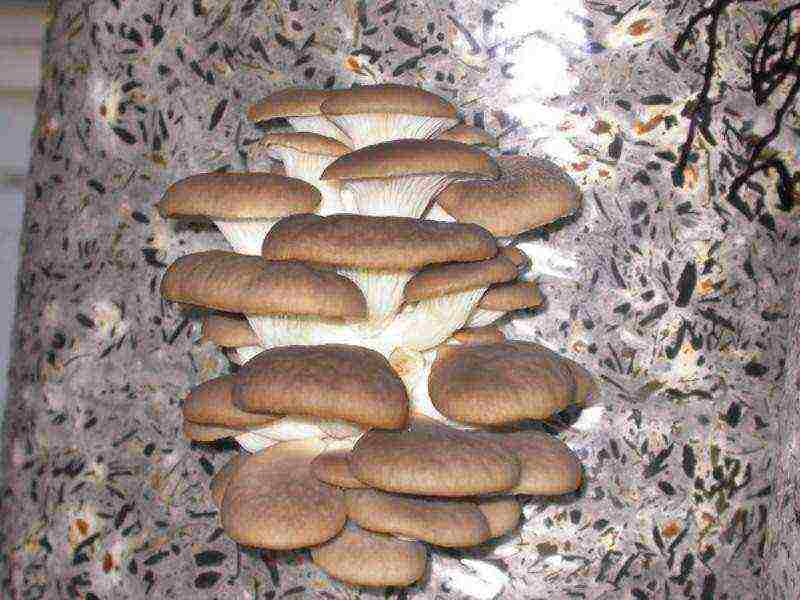 Oyster mushroom is in the first place in terms of prevalence and ease of cultivation. For novice mushroom growers, experienced entrepreneurs who have been engaged in mushroom growing for a long time offer to start growing mushrooms from it. When artificially growing oyster mushrooms, costs are required less than for all other mushrooms. Oyster mushroom is distinguished by unpretentiousness, excellent taste, early maturity, excellent yield, high resistance to viruses and bacteria, as well as rather long shelf life. Oyster mushrooms are grown in plastic bags (with a substrate, mushroom mycelium and bio-additives), on hemp, sawdust of various trees, straw, husk, corn stalks. Mushrooms grow well in rooms with a humidity of 80-85% and at fairly wide temperature ranges (from 10 to 30C, average values 16-20C). The first harvest of mushrooms can be cut after 30 days (in winter after 45). From one mushroom block at a time, it turns out to remove an average of 2.5-3 kg of the crop. At the same time, serve 100 blocks on an area with an area of 30 sq. m. without problems even one person can. Mushrooms produce a harvest for 5 years.
Oyster mushroom is in the first place in terms of prevalence and ease of cultivation. For novice mushroom growers, experienced entrepreneurs who have been engaged in mushroom growing for a long time offer to start growing mushrooms from it. When artificially growing oyster mushrooms, costs are required less than for all other mushrooms. Oyster mushroom is distinguished by unpretentiousness, excellent taste, early maturity, excellent yield, high resistance to viruses and bacteria, as well as rather long shelf life. Oyster mushrooms are grown in plastic bags (with a substrate, mushroom mycelium and bio-additives), on hemp, sawdust of various trees, straw, husk, corn stalks. Mushrooms grow well in rooms with a humidity of 80-85% and at fairly wide temperature ranges (from 10 to 30C, average values 16-20C). The first harvest of mushrooms can be cut after 30 days (in winter after 45). From one mushroom block at a time, it turns out to remove an average of 2.5-3 kg of the crop. At the same time, serve 100 blocks on an area with an area of 30 sq. m. without problems even one person can. Mushrooms produce a harvest for 5 years.- Champignons occupy the next place in terms of the popularity of cultivation, both in an industrial economy and at home. They are much more demanding on the conditions of detention. And the technology of growing them is more expensive than breeding oyster mushrooms. Mushrooms are grown in bags or boxes with soil, in which the mycelium is laid. Champignons grow well in dark, cool rooms (12-18C, maximum value no more than 28C) with a humidity of 65-85%. The first harvest of mushrooms is ready for harvest in 45-50 days, and the next ones can be harvested within 3 months.
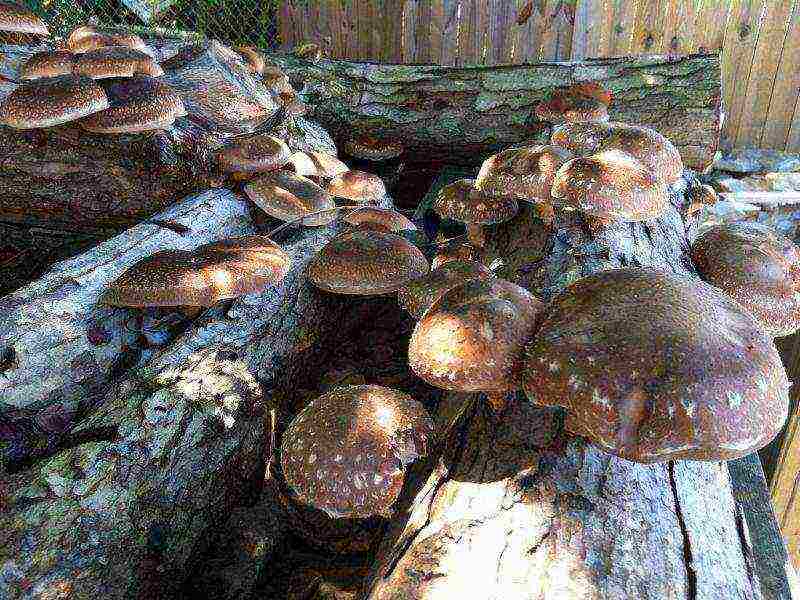 Shiitake - not only tasty, but also a very healing mushroom (successfully used in the treatment of cancer). Until a certain point, it was grown only in Asian countries. Shiitake is one of the most expensive mushrooms (the price is about $ 50 per 1 kg). Grows well at an average temperature of 12C. It is grown on sections of wood and on various substrates. It is important to know that in order to get a harvest of really tasty and healthy shiitake, the mycelium for breeding must be purchased from Japan or China, but not European, because it is spoiled by selection. The first harvest usually begins only in the next year and will last up to three years.
Shiitake - not only tasty, but also a very healing mushroom (successfully used in the treatment of cancer). Until a certain point, it was grown only in Asian countries. Shiitake is one of the most expensive mushrooms (the price is about $ 50 per 1 kg). Grows well at an average temperature of 12C. It is grown on sections of wood and on various substrates. It is important to know that in order to get a harvest of really tasty and healthy shiitake, the mycelium for breeding must be purchased from Japan or China, but not European, because it is spoiled by selection. The first harvest usually begins only in the next year and will last up to three years.- Winter honey - mushroom quite resistant to cold, grows well at ambient temperatures of 1-2 ° C. This mushroom has a pleasant taste and good nutritional value. It perfectly adapts to parasitizing on trees with living wood, and for this reason it should not be grown in backyard gardens or vegetable gardens, it is recommended to grow only on substrates and log cabins indoors.
- Koltsevik - not very well-known mushroom. Its cultivation began relatively recently, only about 25 years ago. This mushroom outwardly resembles a boletus, and in taste competes with champignons. It is grown on a personal plot directly on open ground beds or in plastic bags and boxes.
By becoming familiar with which mushrooms are grown at home, choosing a certain type for yourself and following the rules of caring for them, you will receive a constant tasty source of nutrients.

The technology of growing oyster mushrooms is so simple, does not require special knowledge and significant financial investments, which is available to everyone, even a novice mushroom grower. Oyster mushrooms are grown in bags with a prepared substrate, on stumps and logs, at home or in the country. Sunflower or buckwheat husks, sawdust, corn cobs, straw are suitable for filling the bags.
Growing oyster mushrooms at home
Mushrooms, unlike plants, do not bloom, do not give seeds, and cannot reproduce by cuttings.For their growth, a mycelium, or mycelium, is needed. This is a kind of root system of all mushrooms, outwardly resembling thin white threads. Once in a beneficial environment, these threads grow, forming a mycelium. Under natural conditions, mycelium can occupy tens of kilometers.
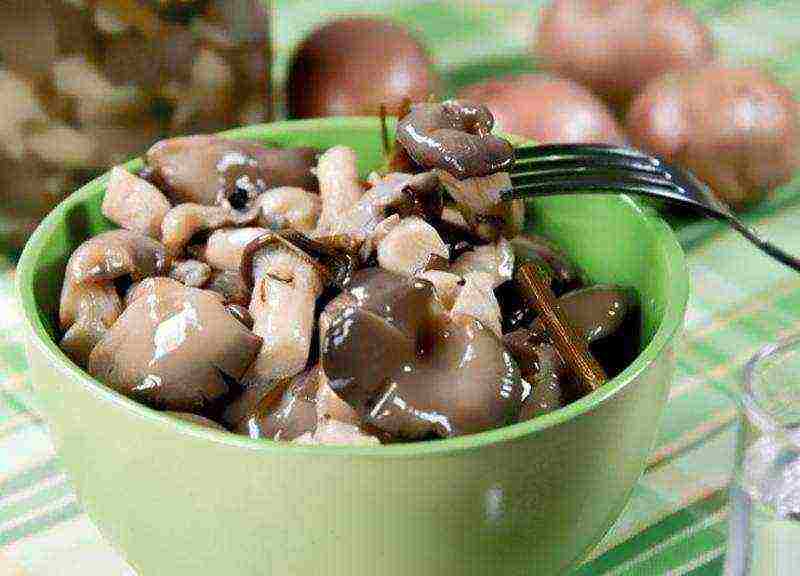 Oyster mushrooms are the most popular mushrooms for home growing
Oyster mushrooms are the most popular mushrooms for home growing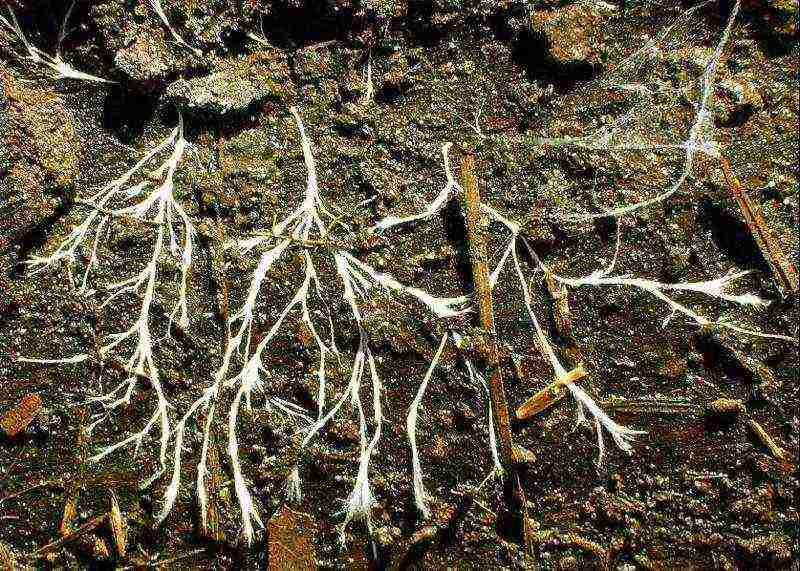 Mushrooms begin to grow from the mycelium
Mushrooms begin to grow from the mycelium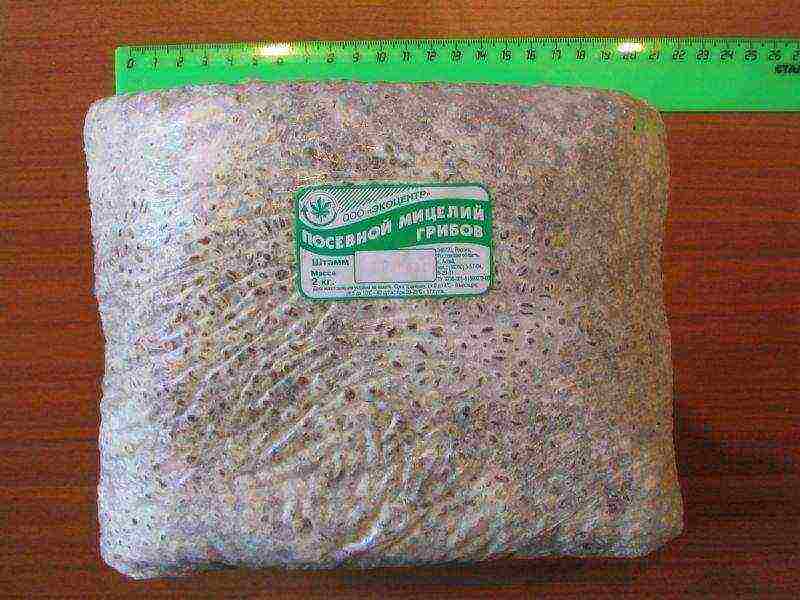 Sowing mycelium of mushrooms can be purchased in specialized stores.
Sowing mycelium of mushrooms can be purchased in specialized stores. The mycelium of the mushrooms grows very quickly, creating a bountiful harvest
The mycelium of the mushrooms grows very quickly, creating a bountiful harvest
Preparing the substrate for mycelium
To get a good result of growing mushrooms at home, you need to take care of a high-quality substrate. It must be dry, not affected by fungus or mold, and free from rot. The harder the raw material is chosen for the substrate, the more thoroughly it should be crushed, leaving pieces up to 4 cm. This is important to retain the required amount of moisture.
The next stage is heat treatment of the crushed raw materials. Having poured it into a suitable container, polypropylene bags made of flour or sugar are suitable for it, place in a container, fill with water until completely immersed and cook for one and a half to two hours. To prevent bags with a light substrate from floating up, you can press them down with a stone, a dumbbell or something heavy. Drain the cooled brew, cool to 26-28 degrees. During cooling, when the hot substrate can already be taken with your hands, it should be squeezed out a little, eliminating excess moisture, or, with large volumes, kept in suspension for at least 12 hours.
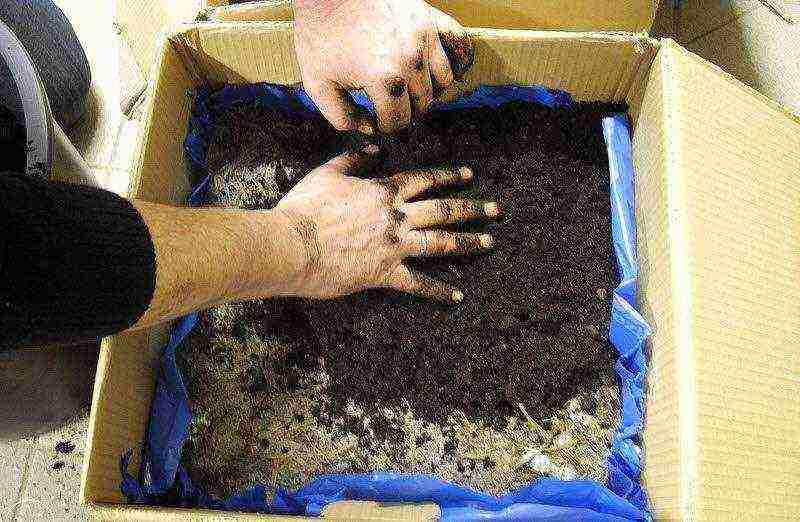 For the mycelium, it is necessary to prepare the substrate
For the mycelium, it is necessary to prepare the substrate
Settling mycelium
While the substrate receives the necessary processing, the mycelium, previously mashed with clean hands, is stored in the refrigerator in a sterilized container. It should be taken out of the refrigerator no later than three hours before mixing with the substrate, giving the opportunity to adapt. The most suitable temperature for him during the creation of the mixture is +21 degrees. To get the greatest yield, you need to take care of the shelf life of the mycelium:
- At a temperature of 0-4 degrees (lower shelf of the refrigerator) - two weeks;
- At + 15-18 - three days;
- At a higher temperature - no longer than a day;
- If you need to keep the mycelium for a month, then you should create temperature conditions for it below zero.
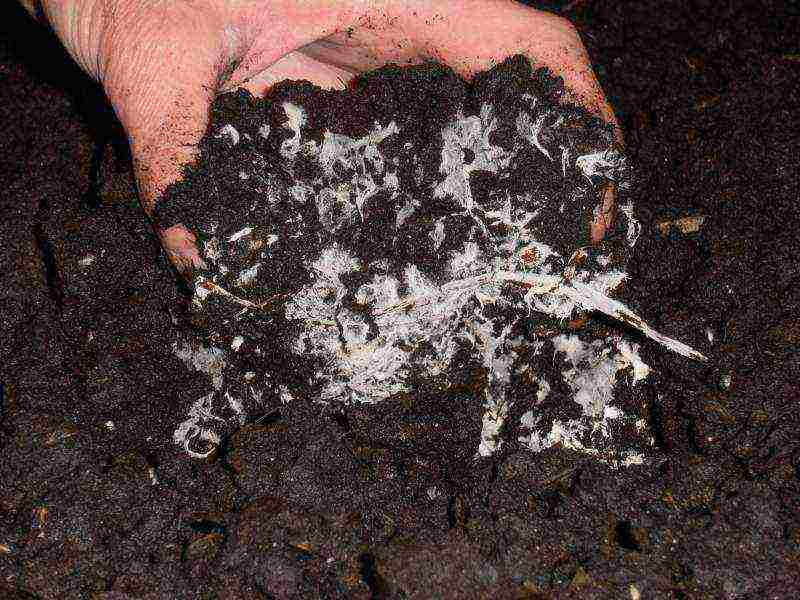 For the mycelium, the mycelium is thoroughly mixed with the substrate.
For the mycelium, the mycelium is thoroughly mixed with the substrate.
Mix the finished moistened substrate with mycelium in a proportion of 1 kg per 400 g, fill plastic bags of any size, tamp them tightly. The formation of voids in the bag, especially in its corners, should not be allowed. From a kilogram of mycelium, up to 10 kg of mushrooms are obtained. It is better to take smaller bags, in them it is easier to control temperature changes inside the mushroom coma. It is enough to rinse new bags. Already used to hold in a solution of bleach for at least two hours. You can fill them in two ways:
- By mixing the substrate with the required amount of mycelium;
- Layers, alternating between 5 cm of substrate and half a centimeter of mycelium, starting and ending with filling the bag with substrate.
Tie the filled bag tightly, pierce with a sharp object or make small cuts across the entire surface in a checkerboard pattern. The distance between the holes should be about 12-15 cm. Experts call this ready-made bag for growing mushrooms at home a block.
 You can grow oyster mushrooms in bags vertically, which saves space
You can grow oyster mushrooms in bags vertically, which saves space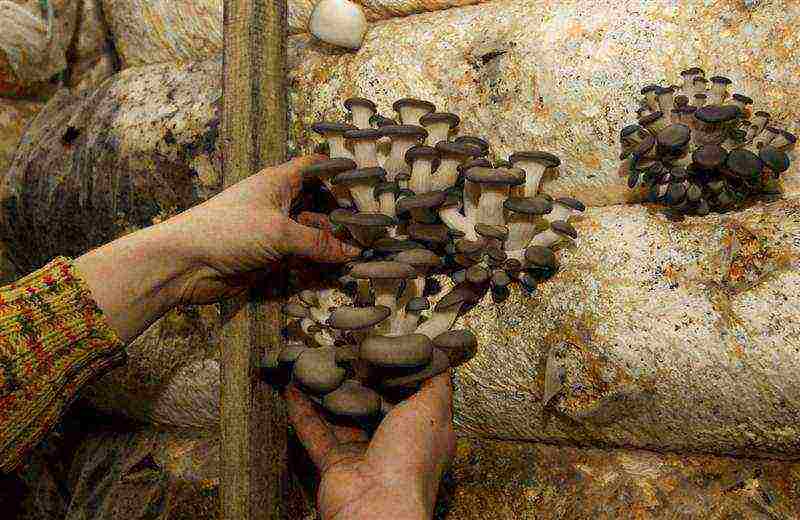 You can grow oyster mushrooms horizontally
You can grow oyster mushrooms horizontally
Incubation period
The next stage of growing oyster mushrooms at home is very important. Place the mushroom blocks in a room with a temperature of + 20-22 degrees and good ventilation. They should not touch each other and the wall. Lighting and watering are not required at this stage. Care should be taken to ensure that flies and other insects do not get into the bags, and regularly ventilate the room.The temperature inside the block must not be allowed to rise above +30 degrees, which can lead to the death of the mycelium. In such conditions, the bags are one and a half to two weeks.
Already on the fifth day, some changes are observed inside the bag. White threads appear, penetrating the entire substrate, a characteristic bloom forms on it. This is the mycelium growing. After one and a half to two weeks, she will completely entangle the lump in the bag, turning it into a dense, homogeneous mass of white color. Subject to all the rules, the block will have a pleasant mushroom smell.
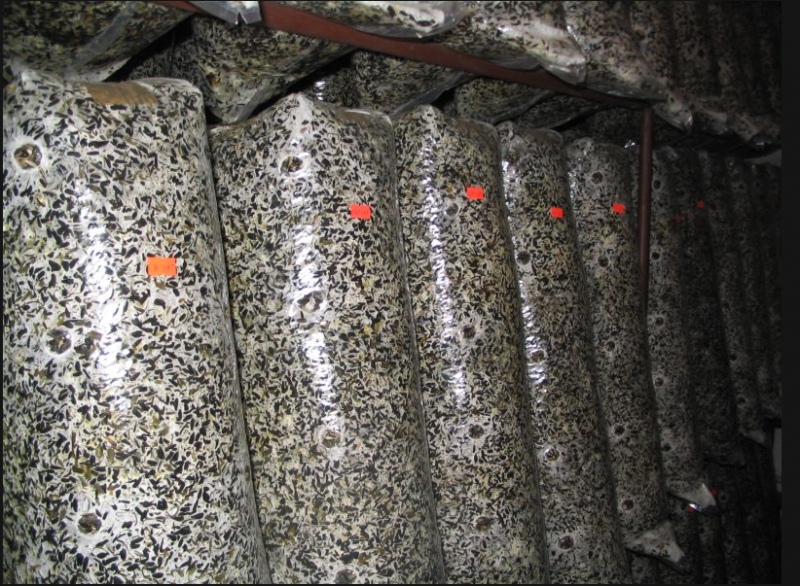 Some time after the preparation of the mycelium, the mycelium completely entangles the substrate in the bag
Some time after the preparation of the mycelium, the mycelium completely entangles the substrate in the bag
The beginning of fruiting
The readiness of oyster mushrooms for the beginning of fruiting are the rudiments of mushrooms that appeared in the slots of the bag. The full fruiting period of the mushroom block is the longest and takes 9-12 weeks. At this time, the air temperature should not be higher than + 10-15 degrees and the conditions for keeping the blocks slightly changed. Mushrooms need to create the most natural growing conditions:
- Lighting. During fruiting, mushrooms need light for at least 10 hours a day. It is enough to create artificial lighting, direct sunlight is unacceptable;
- High air humidity (at least 90%). You can periodically water the walls and floor of the room with water, avoiding it getting on the blocks with mushrooms.
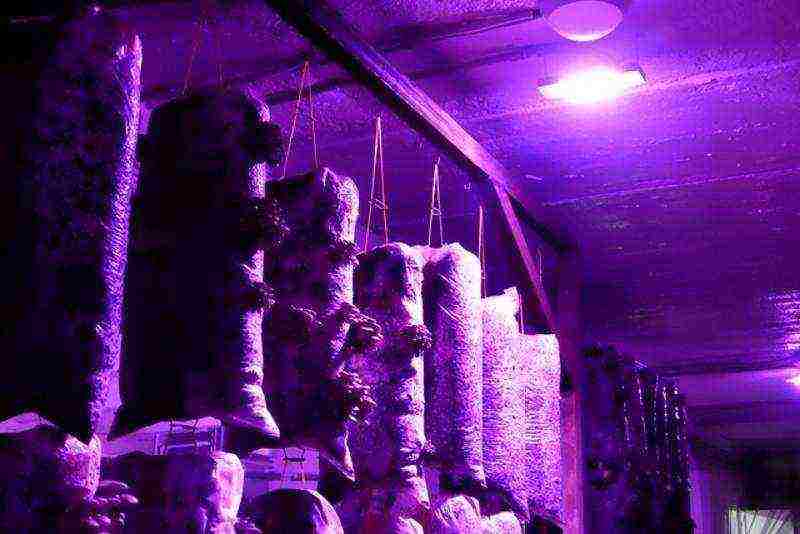 Growing mushrooms requires constant lighting.
Growing mushrooms requires constant lighting.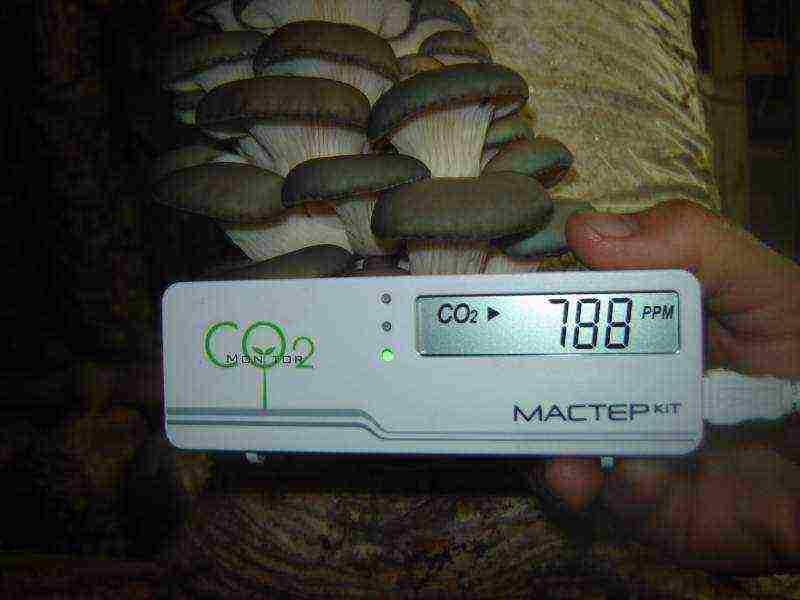 Growing mushrooms requires high humidity and carbon dioxide.
Growing mushrooms requires high humidity and carbon dioxide.
Advice! Special attention should be paid to maintaining the temperature regime. At higher temperatures, mushrooms grow faster, but lose their taste, change color and become brittle. After 10-15 days, all blocks will be covered with neat bunches of mushrooms.
Harvesting
Advice! Overripe mushrooms should not be allowed, a sign of which is the clarification of their caps. At this time, allergenic spores form in their plates, which crumble and can cause an attack of the disease.
Ripe oyster mushrooms are cut with a knife at the very base or carefully twisted out of the substrate. High-quality mushrooms have dark caps, fleshy elastic legs, and they smell delicious mushrooms without any mold. They should be stored in the refrigerator: up to three months in the freezer and no more than a week on the bottom shelf.
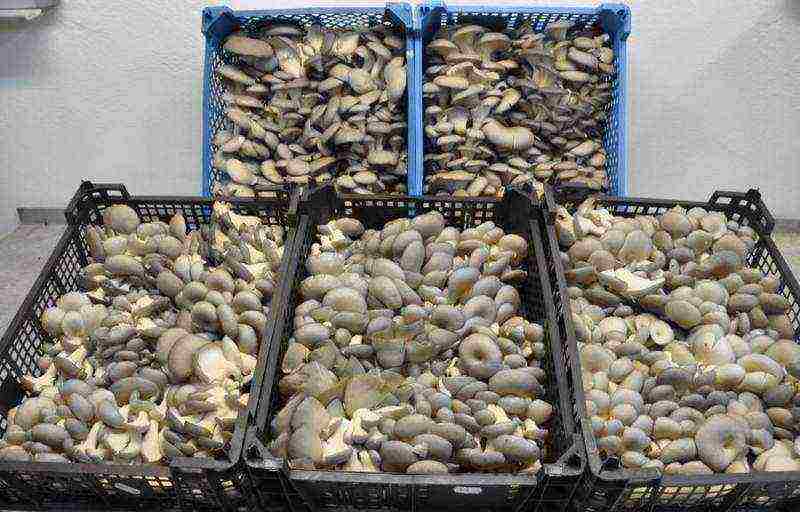 The first harvest of oyster mushrooms is the most numerous and strongest
The first harvest of oyster mushrooms is the most numerous and strongest
After collecting the first wave, you should remove all the remnants of the mushrooms, ventilate the room well and wait two weeks until the next harvest appears. In total, each block can bear fruit up to four times, but with each next stage there are fewer mushrooms. From the first two stages of fruiting, up to ¾ of the expected harvest can be harvested.
Fully fruited blocks are not suitable for the next cultivation of oyster mushrooms at home, because each subsequent harvest becomes more scarce than the previous one. They can be used to replenish the compost heap in the country, use it as an organic fertilizer, feed it to chickens or pigs, just throw it away.
Growing oyster mushrooms in the country
Growing oyster mushrooms on stumps or logs is very convenient in a summer cottage, where there is always an unnecessary cut tree. The mycelium is a good way to easily get rid of the stump remaining after cutting down, completely destroying it in 3-4 years. If there are no stumps on the site, then they can be replaced with logs. They should be freshly cut, still moist and healthy.
Preparing the tree
Advice! Sections of any deciduous and fruit trees up to half a meter long and 15-20 cm in diameter are suitable for mushrooms. They should be kept in water for 3-7 days, changing it daily. Drill holes with a diameter of about a centimeter and a depth of 10-12 cm in the finished logs.
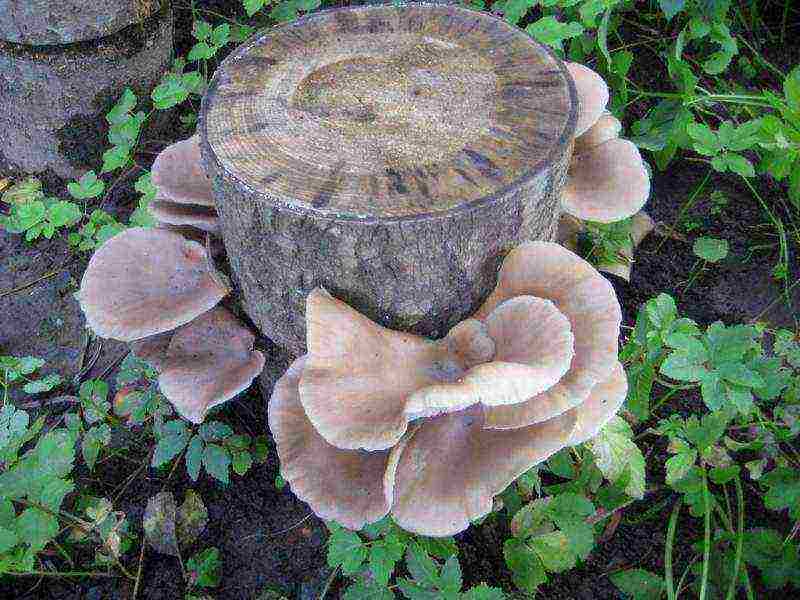 In the country, you can grow oyster mushrooms on a tree stump
In the country, you can grow oyster mushrooms on a tree stump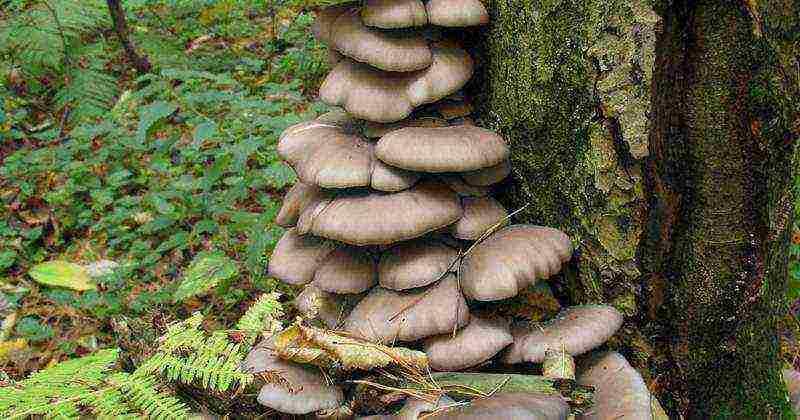 In nature, oyster mushrooms can be found on old trees.
In nature, oyster mushrooms can be found on old trees.
Planting and growing mushrooms
The easiest way to saturate a tree with mycelium is to chop it and push it into the holes, then covering them with moss or bark. A kilogram of mycelium is designed for 7-8 logs of the above size. Place the finished logs on a sand substrate in pre-dug holes 15-20 cm deep, sprinkle with sand or earth on all sides, water lightly and cover with a plastic bag or film. They should be in a shaded place. All care for mycelium consists in periodic watering. The first crop can be harvested in a month and a half. Its ripening rate depends on the wood species and air temperature. These myceliums can bear fruit for up to five years, but the first harvest will be the largest. After it, special care for the block is not required.
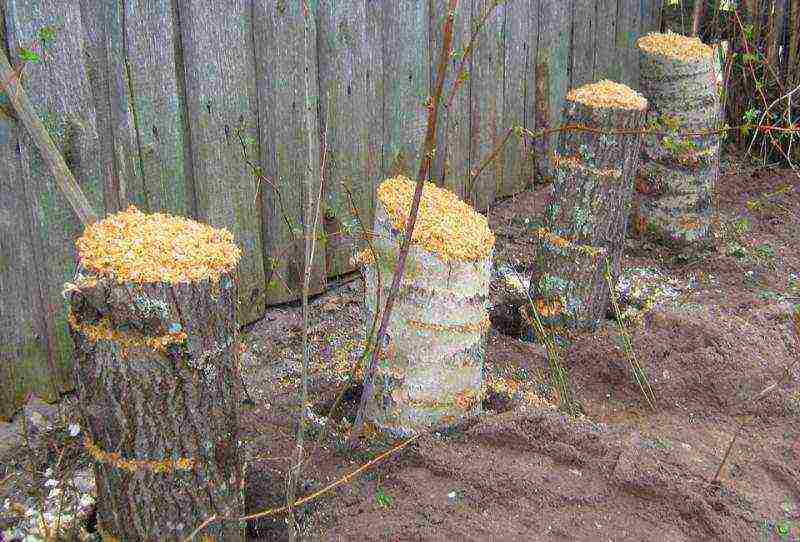 On the stumps for growing oyster mushrooms, it is necessary to make cuts and place the mycelium there
On the stumps for growing oyster mushrooms, it is necessary to make cuts and place the mycelium there
If the preparation of a substrate for growing oyster mushrooms at home seems rather complicated and burdensome, then in specialized farms engaged in industrial mushroom growing, you can purchase ready-made mushroom blocks. It is enough just to place these bags in the right conditions to harvest after a while.
Varieties of mushrooms for home growing
Oyster mushroom is the most common and unpretentious mushroom, so you can easily grow it at home. It is perfect for novice mushroom growers, as you can familiarize yourself with the technology using its example, as well as get an excellent harvest. But if for some reason this mushroom did not suit your taste, we will tell you about other varieties that you can breed on your own. Agree, it's good when you don't need to go to the forest for fragrant mushrooms. Of course, they are not difficult to get in any supermarket, but you cannot be sure of the quality of the store products. Now let's take a closer look at varieties suitable for home growing.
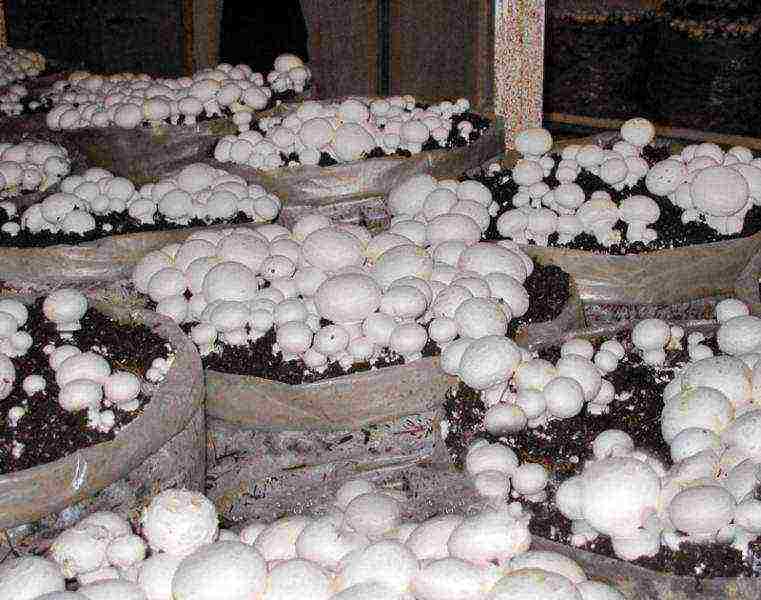 Champignons can also be grown in bags
Champignons can also be grown in bags
- Champignon. Few people know, but the harvest of this mushroom can also be obtained at home. We are more familiar with it as a species grown in industry, so few people thought about planting it in a country house or in a private house. Champignon has excellent taste, so it can be found in recipes for preparing a variety of dishes. It is worth noting that this mushroom is quite picky about growing conditions, so get ready to work hard to get the harvest. By the way, mushrooms are planted in boxes or bags filled with special soil, so the technology of growing them involves a little more waste than when planting, say, oyster mushrooms.
- Shiitake. It is characterized not only by excellent taste, but also by medicinal properties. It is often included in the diet of patients with cancer. This species came to us from China and Japan, where it has already become widespread. Healing properties are not the only reason why this mushroom is so revered. It is considered a delicacy because of its exquisite taste and pleasant aroma. It is not strange that a shiitake is quite expensive, or to be more precise, within $ 50 per kilogram. Agree, the possibility of growing such a unique mushroom at home looks very tempting. But here it should be noted that it is possible to grow a mushroom with medicinal properties only from the mycelium of Chinese or Japanese production. You should not buy European myceliums, as they have long been spoiled by selection.
- Winter honey mushroom. Perfect for growing in the country, due to its resistance to low temperatures. It grows well at temperatures of 1-2 ° C, so you don't have to worry about it even on frosty days. Winter honey is famous for its delicate taste, high nutritional value and excellent aroma.Interestingly, this mushroom loves to grow on living trees, parasitizing them, so it is not recommended to grow it in the garden. It is better to plant the mycelium indoors by placing pieces of wood there or planting the mycelium in the substrate.
- Ring piece. If you haven't heard of this mushroom, don't be surprised. It began to be cultivated relatively recently, so it did not have time to become widespread in our region. This mushroom is a bit like a birch, and in terms of taste, it can compete even with champignon. By the way, you can plant a ringlet directly into open soil, placing it on the garden beds. It is also possible to grow in special boxes and plastic bags.
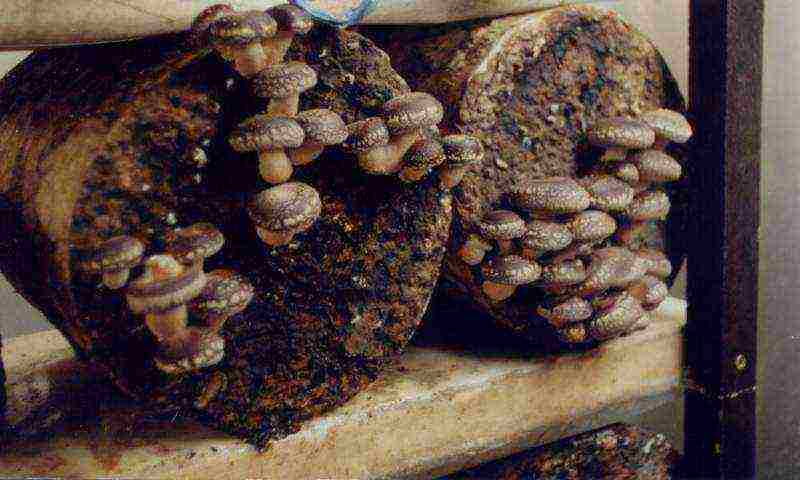 In the basement, shiitake can be grown on a tree
In the basement, shiitake can be grown on a tree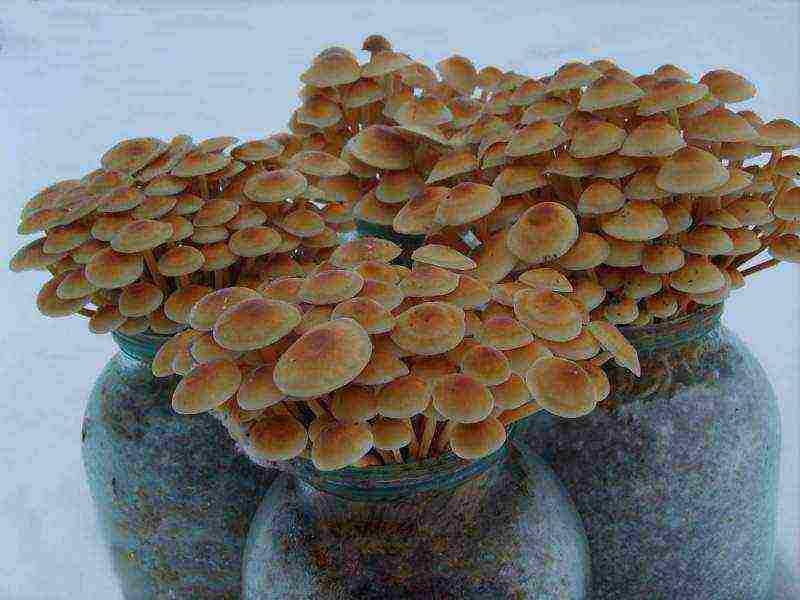 You can grow winter mushrooms in banks on a substrate
You can grow winter mushrooms in banks on a substrate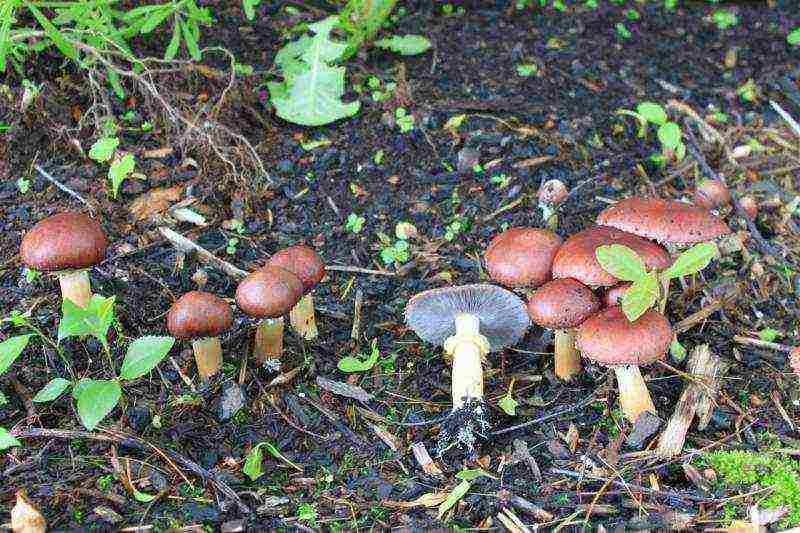 Ringworm mushrooms grow well in normal soil.
Ringworm mushrooms grow well in normal soil.
Summing up
As you can see, growing mushrooms at home is not that difficult. Your task is to choose the mushroom you like, carefully study the technology of its cultivation and strictly follow the instructions of experienced mushroom pickers. If you do everything right, your own grown mushrooms will certainly delight you with their wonderful taste and delicate aroma. Good luck!

